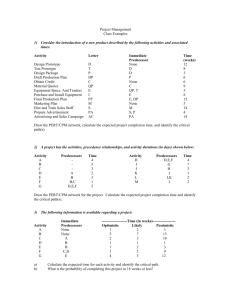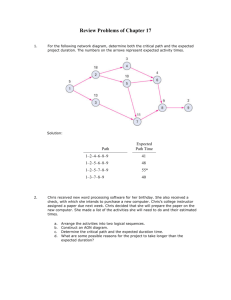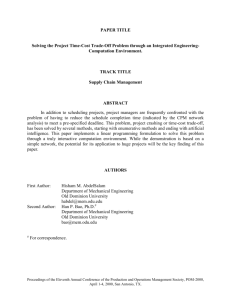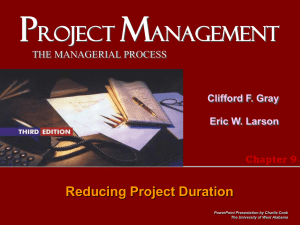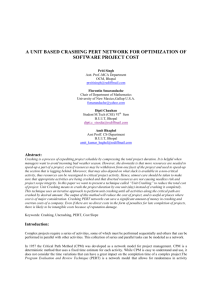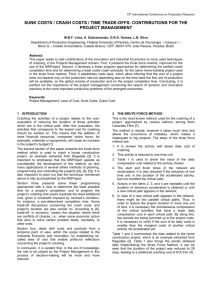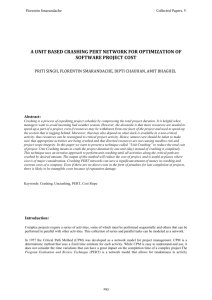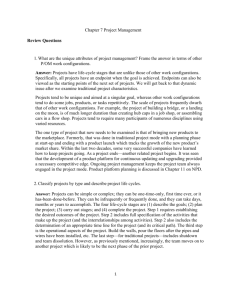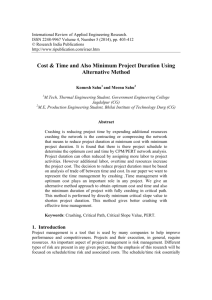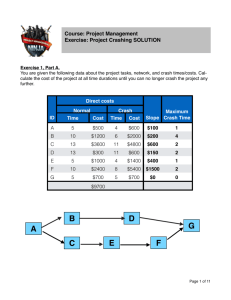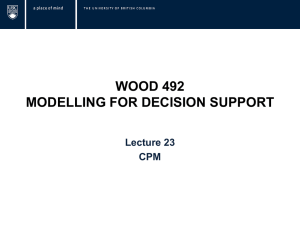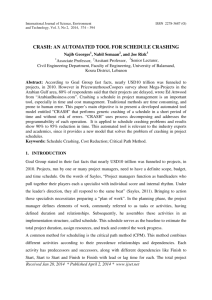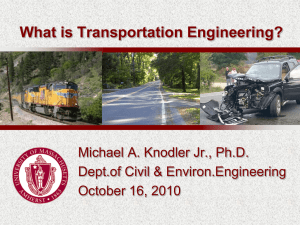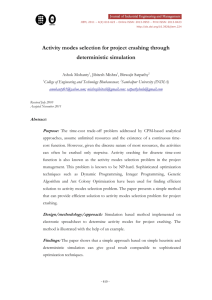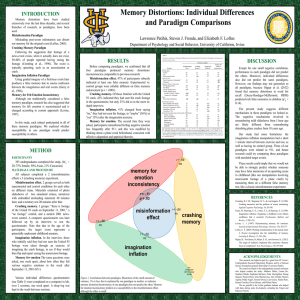Chapter 8 - Project Management Chapter topics
advertisement
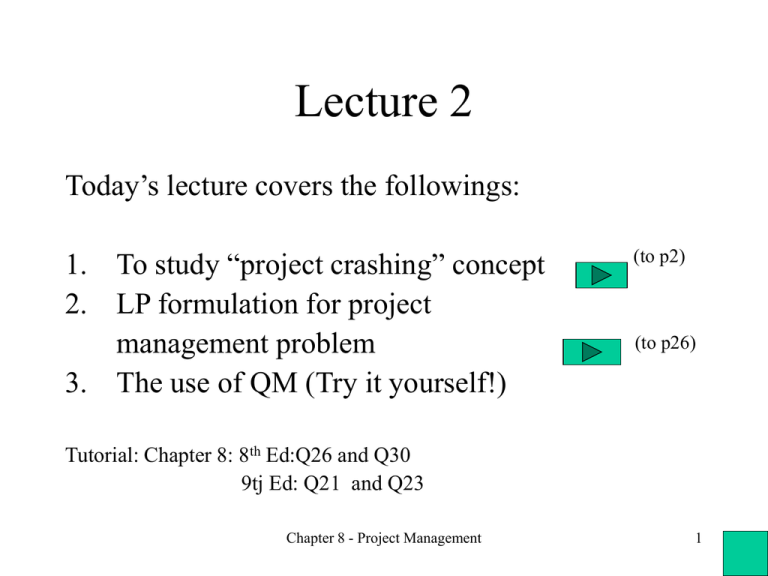
Lecture 2 Today’s lecture covers the followings: 1. To study “project crashing” concept 2. LP formulation for project management problem 3. The use of QM (Try it yourself!) (to p2) (to p26) Tutorial: Chapter 8: 8th Ed:Q26 and Q30 9tj Ed: Q21 and Q23 Chapter 8 - Project Management 1 Project Crashing Basic Concept In last lecture, we studied on how to use CPM to determine solution for a project problem There, we determine its critical path and completion time. Question: Can we cut short its project completion time? (to p3) If so, how! Chapter 8 - Project Management 2 Project Crashing Solution! Yes, the project duration can be reduced by assigning more resources to project activities But, doing this would somehow increase our project cost! How do we strike a balance? Chapter 8 - Project Management (to p4) 3 Trade-off concept Here, we adopt the “Trade-off” concept • ie, we attempt to “crash” some “critical” events by allocating more sources to them, and also to maintain a balance that the shortening time is not less than the normal activities (to p5) • How to do that: • Question: What criteria should it be based on when deciding to crashing critical times? Chapter 8 - Project Management 4 (to p11) Example – crashing (1) Max weeks can be crashed Normal weeks 5 (1) 1 2 6(3) 3 5(0) The critical path is 1-2-3, the completion time =11 How? Path: 1-2-3 = 5+6=11 weeks Path: 1-3 = 5 weeks Now, how many days can we “crash” it? Chapter 8 - Project Management (to p6) 5 Example – crashing (1) 5 (1) 1 2 6(3) 3 5(0) The maximum time that can be crashed for: Path 1-2-3 = 1 + 3 = 4 Path 1-3 = 0 Total weeks can be crashed = 4 + 0 = 4 Are we to use up all these 4 weeks? Chapter 8 - Project Management (to p7) 6 Example – crashing (1) 4(0) 5 (1) 1 3(0) 2 6(3) 3 5(0) If we used all 4 days, then path 1-2-3 has (5-1) + (6-3) = 7 completion weeks Now, we need to check if the completion time for path 1-3 has lesser than 7 weeks (why?) Now, path 1-3 has (5-0) = 5 weeks Since path 1-3 still shorter than 7 weeks, we used up all 4 crashed weeks Question: What if path 1-2 has, say 8 week completion time? Chapter 8 - Project Management (to p8) 7 Example – crashing (1) Such as 5 (1) 2 6(3) 3 1 8(0) Now, we cannot use all 4 days (Why?) Because path 1-2-3 will not be critical path anymore as path 1-3 would now has longest hour to finish Rule: When a path is a critical path, it will stay as a critical path So, we can only reduce the path 1-2-3 completion time to the same time As path 1-2. (HOW?) Chapter 8 - Project Management (to p9) 8 Example – crashing (1) Solution: 5 (1) 2 6(3) 3 1 8(0) We can only reduce total time for path 1-2-3 = path 1-2, that is 8 weeks If the cost for path 1-2 and path 2-3 is the same then We can random pick them to crash so that its completion Time is 8 weeks Chapter 8 - Project Management (to p10) 9 Example – crashing (1) Solution: 4(0) 5 (1) 3 1 OR 8(0) 5 (1) 1 2 4(1) 6(3) 2 3(0) 6(3) 3 8(0) Now, paths 1-2-3 and 1-3 are both critical paths Chapter 8 - Project Management (to p4) 10 Time-cost Trade-off In this subject, the decision for “crashing” the project is based on the trade-off between “time and cost” The method is called “Time-cost Trade-off” How it works? – We determine an average crash cost for each event • How to do that? (to p12) – Procedural step. (to p13) Chapter 8 - Project Management 11 Project Crashing and Time-Cost Trade-Off Example Problem (1 of 3) A B C D E=(A-B) F= (D-C)/(A-B) F Table 8.5 Normal Activity and Crash Data for the Network in Figure 8.16 Note: A,B,C,D are given We need to compute E and F Note: we will use F values to decide(to p11) 12 which path to crash! Time-Cost Trade-Off Steps: 1. use “normal cost” to determine the critical path 2. for each event, compute their average crash cost 3. for each section of critical path, crash their maximum time by retaining this section be part of the “critical” path. 4. compute total crashing costs and completion time Example (to p14) Chapter 8 - Project Management 13 Example: trade-off • • • • • Consider the same example as show in below Step 1 determine it critical path Step 2 determine all average unit crash cost Step 3 crashing events with minimum costs Step 4 compute crashed weeks and costs More example! Chapter 8 - Project Management (to p21) (to p15) (to p16) (to p17) (to p20) 14 Step 1 • Using CPM, the critical path is 1-2-3-4-6-7 (to p14) Chapter 8 - Project Management 15 Step 2 (to p14) Chapter 8 - Project Management 16 Step 3: First, we cluster each segment of critical path into sections that can be crashed and to consider to crash them one section at a time Section1 Section 2 Section 3 Section 4 (to p18) 17 Step 3: We now add the normal and crashed time and cost to each segment 8(3) $500 12(3) $$7000 12(5) $400 4(1) $7000 4(1) $3000 4(3) $$200 4(3) $$200 Section1 Section 2 Section 3 Section 4 (to p19) 18 Step 3: We now crashed them one section at a time as follows: 5(0) 8(3) $500 9(0) 7(0) 12(3) $$7000 12(5) $400 3(0) 4(1) $7000 4(1) $3000 4(3) $$200 4(3) $$200 Section1 Section 2 Section 3 Section 4 (to p14) 19 Step 4: We now crashed them one section at a time as follows: 5(0) 8(3) $500 9(0) 7(0) 12(3) $$7000 12(5) $400 3(0) 4(1) $7000 4(1) $3000 4(3) $$200 4(3) $$200 Total crash cost =(5*$400)+(3*$500)+(3*$7000)+(1*$7000)= 31,000 Total crashed weeks= 5+3+3+1=12 Note: critical path is 1-2-3-4-6-7 Completion time = 7+5+0+9+3 = 24 (to p14) 20 Crashed cost 10(5) 1 5(4) 3 4 4(1) 4(2) 2 How to solve this problem? (to p22) Chapter 8 - Project Management 21 Further detail steps 1. Determine the critical path 2. Crash the critical path to the level where other non-critical paths become a critical one 3. Consider for further crashing until all possible crashing resources were consumed! (to p23) Chapter 8 - Project Management 22 Critical path 10(5) 1 5(4) 3 4 4(1) 4(2) 2 The critical path is 1-3-4, completion time is 10+5 = 15 Chapter 8 - Project Management (to p24) 23 Crash to a level to which other noncritical path is introduced 5(0) 10(5) 1 3(2) 5(4) 3 4 4(3) 4(2) 2 Both critical Paths = 8 The non-critical path is 1-2-4, has the processing time = 4+4 = 8 (to p25) So, we try to reduce the critical path to this level ! Chapter 8 - Project Management 24 Crash all resources until no further can be reduced! 2(0) 3(1) 5(3) 5(0) 10(5) 1 3 4(3) 3(2) 4 4(2) 2 Both critical Paths = 7 Stop, since no more resources can be reduced in path 1-3-4 (to p1) Chapter 8 - Project Management 25 Formulating the CPM/PERT Network as a Linear Programming Model - The objective is to determine the earliest time the project can be completed (i.e., the critical path time). • normal CPM (to p27) • crashing model (to p30) (to p1) Chapter 8 - Project Management 26 LP formulation General linear programming model is: minimize Z = cixi subject to xj - xi tij for all activities i j x i, x j 0 where xi = earliest event time of node i xj = earliest event time of node j tij = time of activity i j (to p28) • LP formulation for the project management Chapter 8 - Project Management 27 LP for the CPM • Let consider a simple problem as outlined as follows: Let xi be denote as each node i And segment of say path 1-2 as x2-x1 Then (to p29) Chapter 8 - Project Management 28 Objective is Minimize Z = x1 + x2 + x3 + x4 + x5 + x6 + x7 x2 - x1 12 (for path 1-2) x3 - x2 8 (for path 2-3) x4 - x2 4 (for path 2-4) x4 - x3 0 (for path 3-4) x5 - x4 4 (for path 4-5) x6 - x4 12 (for path 4-6) x6 - x5 4 (for path 5-6) x7 - x6 4 (for path 6-7) xi, xj 0 Do you know how to read the results from the LP output? Subject to Chapter 8 - Project Management (to p26) 29 General concept • All formulation of CPM is used, except we need one more variable to represent the crashed cost per unit of each path • Example! (to p31) Chapter 8 - Project Management 30 Consider again the following crashed cost as an example - Objective is to reduce the project duration from 36 to 30 weeks at the minimum possible crash cost. Our objective is to min these How? We now y to represent these Chapter 8 - Project Management (to p32) 31 Min 400y12 + 500y23 + 3000y24 + 0y34 + 200y45 + 7000y46 + 200y56 + 7000y67 And all yij <= their total allowance crash time A complete model is shown in next slide Chapter 8 - Project Management (to p33) 32 The CPM/PERT Network as a Linear Programming Model Example Problem Project Crashing - Model Formulation xi = earliest event time of node i xj = earliest event time of node j yij = amount of time by which activity i j is crashed (i.e., reduced) minimize Z = $400y12 + 500y23 + 3000y24 + 200y45 + 7000y46 + 200y56 + 7000y67 subject to Max crashing time for critical path i.e. total allowable crashed time New set of equations CPM value y12 5 y12 + x2 - x1 12 y23 3 y23 + x3 - x2 8 y24 1 y24 + x4 - x2 4 y34 0 y34 + x4 - x3 0 y45 3 y45 + x5 - x4 4 y46 3 y46 + x6 - x4 12 y56 3 y56 + x6 - x5 4 y67 1 x67 + x7 - x6 4 x7 30 xj, yij 0 Chapter 8 - Project Management (to p26) 33
